What To Eat: The Must-Try Appetizing Dishes To Try In Bali
Bali is a province of Indonesia and the westernmost of the Lesser Sunda Islands. East of Java and west of Lombok, the province includes the island of Bali and a few smaller neighbouring islands, notably Nusa Penida, Nusa Lembongan, and Nusa Ceningan. The provincial capital, Denpasar, is the most populous city in the Lesser Sunda Islands and the second-largest, after Makassar, in Eastern Indonesia.
Bali's most renowned dishes, made rich by the heavy use of local herbs and spices, are traditionally eaten during the colorful Hindu ceremonies that punctuate life on the Indonesian island. Babi guling, or suckling pig, is one of Bali’s most famous dishes. It is very unlikely to find this dish outside of Bali since a majority of the population in Indonesia are Muslim. Babi guling literally translates to “turning pig” since it is hand turned on an open fire. In the past, babi guling was only served in religious ceremonies or huge celebrations but due to the increase in tourism, you can find it many restaurants now.
1. Gado Gado
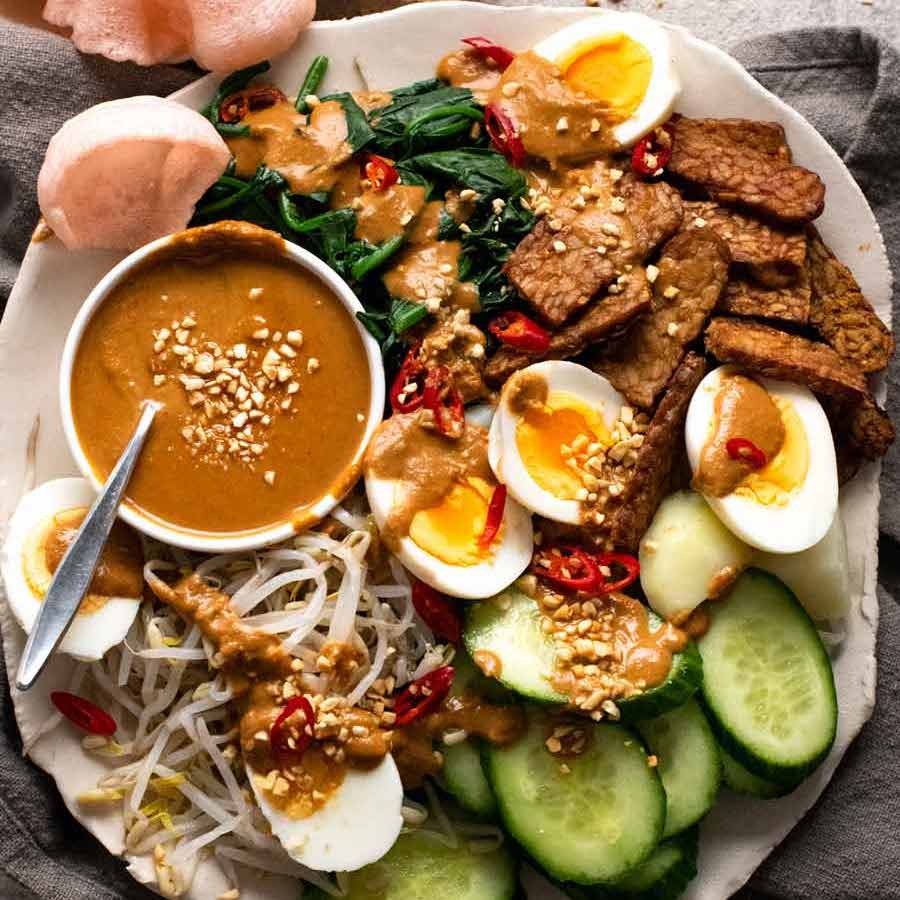 |
| Photo: RecipeTin Eats |
Gado-gado (Indonesian or Betawi) is an Indonesian salad of raw, slightly boiled, blanched or steamed vegetables and hard-boiled eggs, boiled potato, fried tofu and tempeh, and lontong (rice wrapped in a banana leaf), served with a peanut sauce dressing. In 2018, gado-gado was promoted as one of six national dishes of Indonesia; the others are soto, sate, nasi goreng, tumpeng, and rendang.
The term gado or the verb menggado means to consume something without rice. Gado-gado in Indonesian literally means "mix-mix" since it is made of a rich mixture of vegetables such as potatoes, longbeans, bean sprouts, spinach, chayote, bitter gourd, corn and cabbage, with tofu, tempeh and hard-boiled eggs, all mixed in peanut sauce dressing, sometimes also topped with krupuk and sprinkles of fried shallots. Gado-gado is different from lotek atah or karedok which uses raw vegetables. Another similar dish is the Javanese pecel.
Some eating establishments use different mixtures of peanut sauce, such as adding cashew nuts for taste. In Jakarta, some eating establishments boast gado-gado as their signature dish, some of which have been in business for decades and have developed faithful clientele. For example, Gado-Gado Boplo restaurant chain has been around since 1970, while Gado-Gado Bonbin in Cikini has been around since 1960.
Gado-gado sauce is not to be confused with satay sauce, which is also a peanut sauce.
2. Mie Goreng
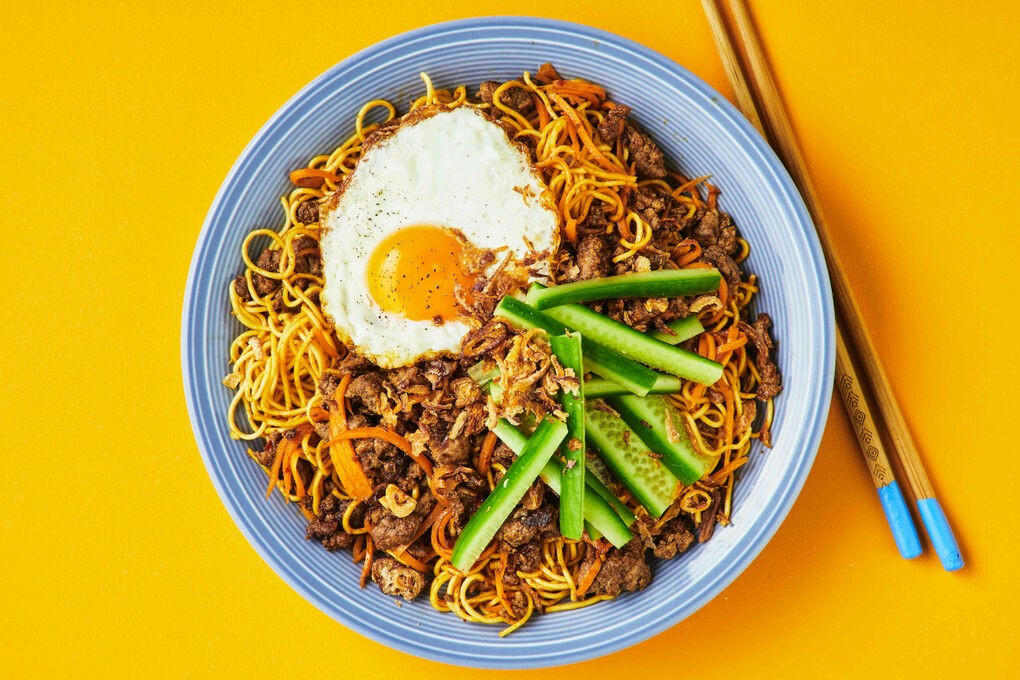 |
| Photo: Dinnerly |
Mie goreng, also known as bakmi goreng, is an Indonesian style of stir fried noodle dish. It is made with thin yellow noodles stir fried in cooking oil with garlic, onion or shallots, fried prawn, chicken, beef, or sliced bakso (meatballs), chili, Chinese cabbage, cabbages, tomatoes, egg, and other vegetables. Ubiquitous in Indonesia, it is sold by food vendors from street-hawkers, warungs, to high-end restaurants.
Mie goreng are traditionally made with yellow wheat noodles, stir fried with chopped shallots, onion, and garlic with soy sauce seasoning, egg, vegetables, chicken, meat or seafood. However, other versions might use dried instant noodle instead of fresh yellow wheat noodle. A common practice in Indonesia is the inclusion of the powdered instant noodle seasonings, along with egg and vegetables. Authentic mie goreng uses fresh ingredients and spices, however, bottled instant spice paste might be used for practical reasons.
The almost identical recipe is often used to create other dishes. For example bihun goreng is made by replacing yellow wheat noodle with bihun or rice vermicelli, while kwetiau goreng uses shahe fen or thick flat rice noodles instead.
3. Babi guling
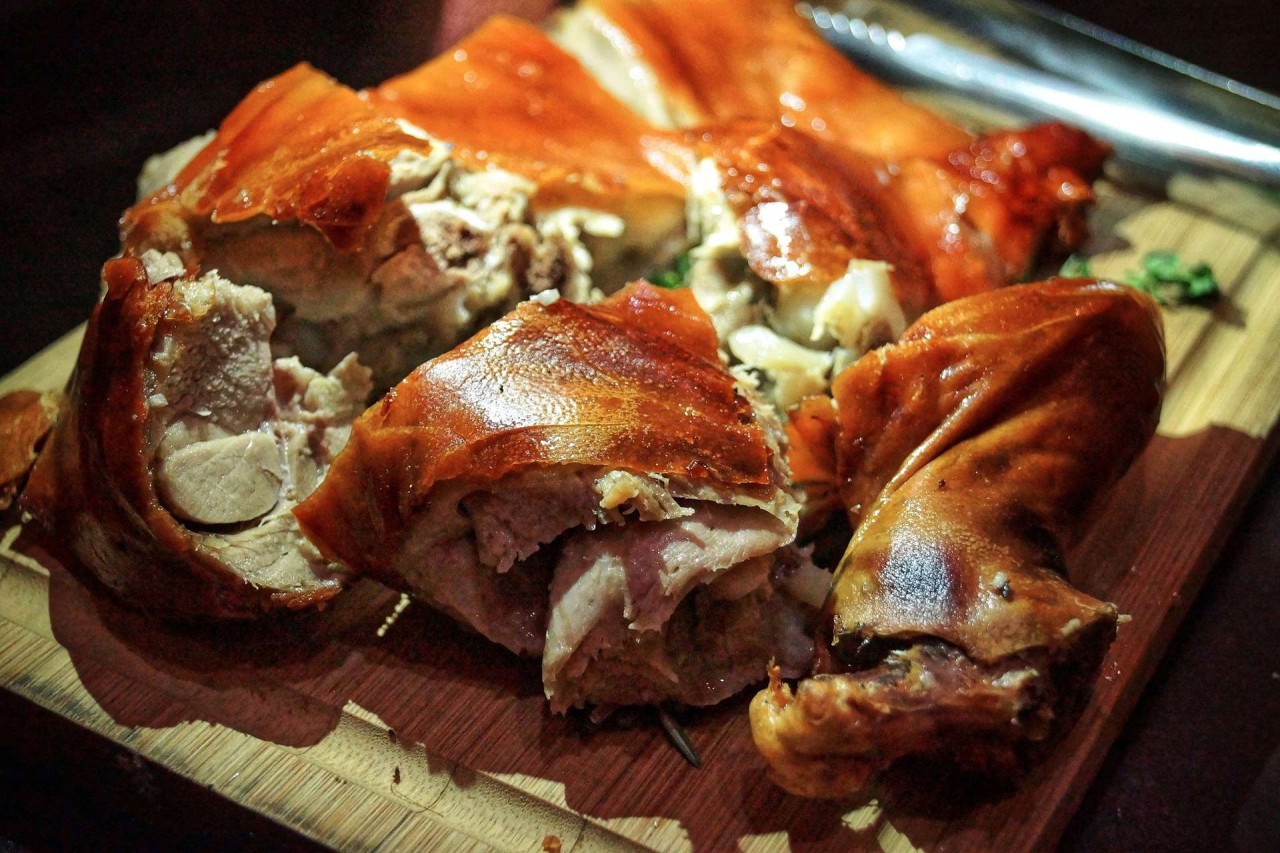 |
| Photo: Two Fish Divers |
Babi guling is the Indonesian version of a roast suckling pig. Although not common to other Indonesian regions, on Bali, where the predominant religion is Hinduism, it is one of the most popular dishes. Before roasting, pig's skin is usually rubbed with turmeric, and the animal is stuffed with a basa gede spice mixture, which usually includes turmeric, coriander, lemongrass, shallots, galangal, chili, shrimp paste, and garlic.
Pork is then placed on a spit and roasted over an open fire. This Balinese delicacy is usually served during special occasions and formal gatherings, but can often be found in warungs, traditional Indonesian casual eateries. The dish is so popular in Bali that most warungs specialize and serve only babi guling as their signature dish.
When the pig is roasted, the crisp amber-colored skin is carefully removed, and the meat is cut into chunks. Each serving of babi guling is supposed to have a chunk of juicy meat, a piece of crispy skin, and a tablespoon of the flavorful stuffing.
Babi guling is often served with steamed rice, fresh vegetables, and a dollop of spicy Indonesian condiment known as sambal.
4. Lawar
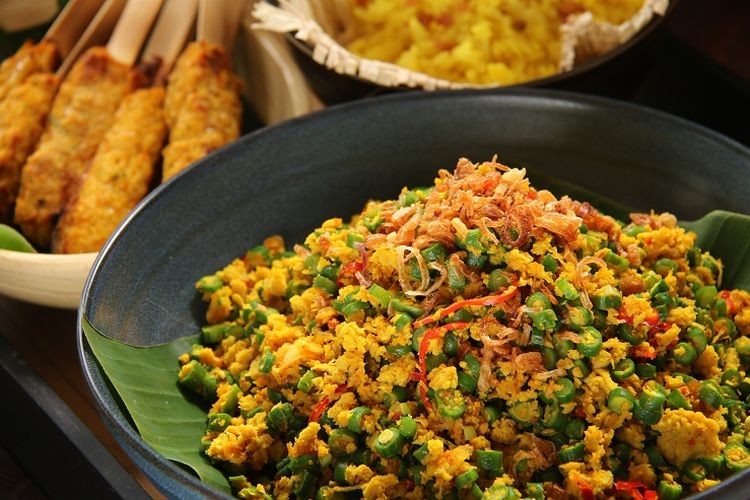 |
| Photo: Ubud Villas Rental |
Lawar is an Indonesian dish created from a mixture of vegetables, coconut and minced meat mixed with rich herbs and spices, originating from Bali, Indonesia. This dish is commonly found in restaurants and warungs in Bali. Despite its rich vegetables mixture, lawar is not a vegetarian dish, since most often it is mixed with minced meat or even blood.
Lawar consists of green beans, beaten eggs, vegetable oil, kaffir lime leaves, coconut milk, palm sugar, fresh grated coconut, and fried shallots, all stir fried in coconut oil. Lawar is named according to its additional protein ingredients, for example lawar with chicken is called chicken lawar, lawar mixed with pork is called pork lawar. Lawar which uses young jackfruit is called jackfruit lawar.
Some types of lawar might add the blood of butchered animal (usually pork or chicken blood) mixed with spices to add taste. Because of its rich protein and fat content acquired from coconut milk and perhaps blood, lawar spoils easily and it should be consumed immediately; it is usually good for half a day before going bad. Sometimes lawar is named according to its color: lawar merah (red lawar) refer to its blood content, and lawar putih (white lawar) only coconut without any blood. Lawar padamare is the type of combination of several types of lawars. Lawar is served with steamed rice and other meat dish such as babi guling (roasted suckling pork).
5. Bebek Betutu
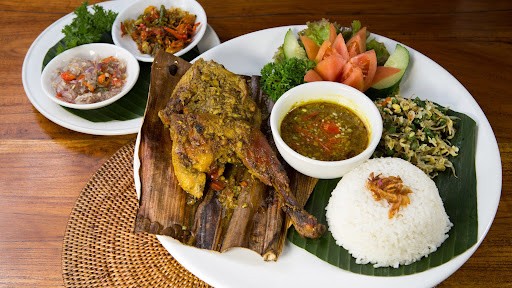 |
| Photo: Bepvang |
Betutu is an Balinese dish of steamed or roasted chicken or duck in rich bumbu betutu (betutu spice mix). This highly seasoned and spiced dish is a popular dish in Bali and Lombok, Indonesia. An even spicier version is available using extra-spicy sauce made from uncooked (raw) onion slices mixed with red chili peppers and coconut oil.
Betutu is a richly spiced Balinese poultry dish. It is often called according to its main ingredients; ayam betutu is chicken betutu, while bebek betutu is the duck version. This traditional dish can be found on the menu of luxury hotels or restaurants in Bali, and it is popular among tourists.
The term betutu is the Balinese word for a certain spice mixture (bumbu) which consist of shallots, garlic, turmeric, ginger, wild ginger, galangal, candle nuts, chili peppers, shrimp paste, and peanuts all finely ground using mortar and pestle. The betutu spice paste is sauteed with coconut oil to release its aroma, and applied to poultry, chicken or duck. Common side dishes may include plecing kangkung, crispy-fried peanuts and sambal terasi.
6. Sate lembat
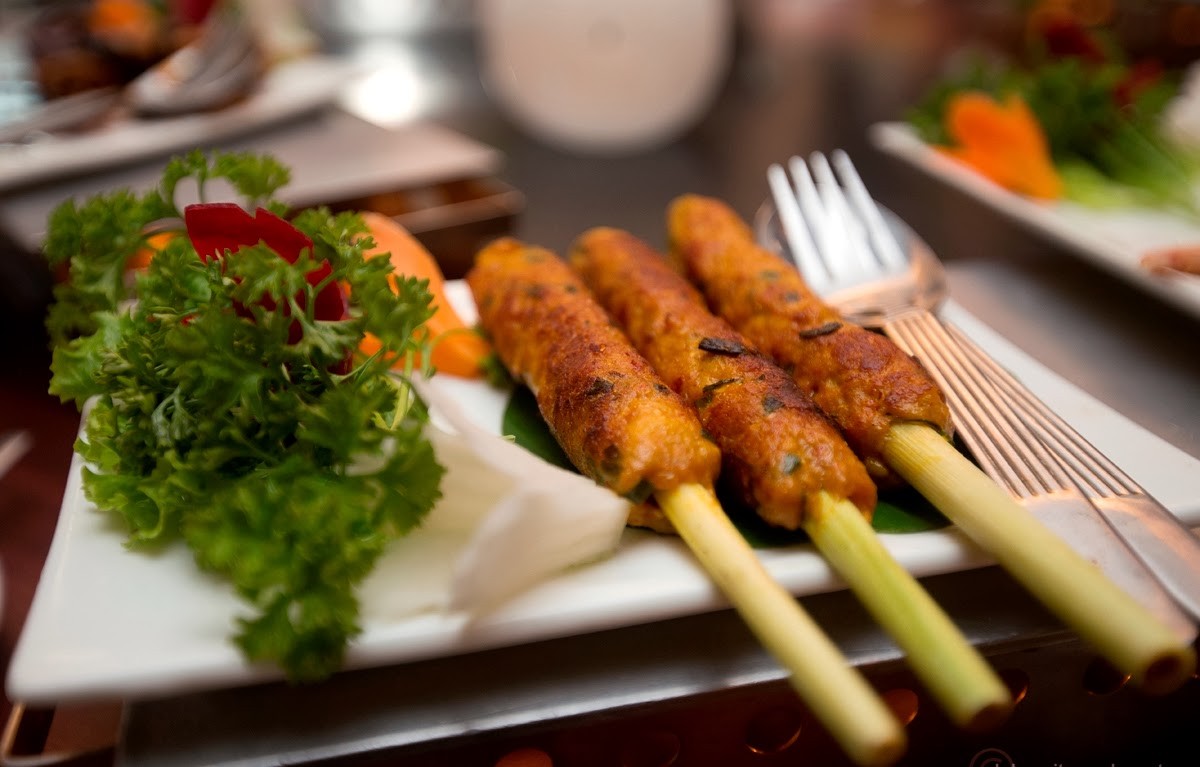 |
| Photo: Dammedulich |
Bali's take on satay, the classic meat-on-a-stick dish found across the Indonesian archipelago, is minced meat pounded in a mortar and pestle with young grated coconut and a bumbu, or spice mixture, that varies according to region.
It may be similar to the pastes used in babi guling or bebek betutu but perhaps with cardamom, cinnamon, nutmeg, tamarind or cumin seeds also making an appearance. The seasoned meat is shaped around a split bamboo skewer and quickly barbecued, often while hand-fanned, over hot coals.
Forget the peanut sauce found elsewhere, sate in Bali is accompanied with shrimp paste-based sambal "matah", meaning raw or alive.
Sate is a popular street food dish so it can be found at any busy market, but a higher-end option is the Alila Uluwatu's Warung (Jalan Belimbing Sari, Banjar Tambiyak, Desa Pecatu), where the sate lilit ikan is served on aromatic lemongrass skewers, according to CNN.
7. Laklak
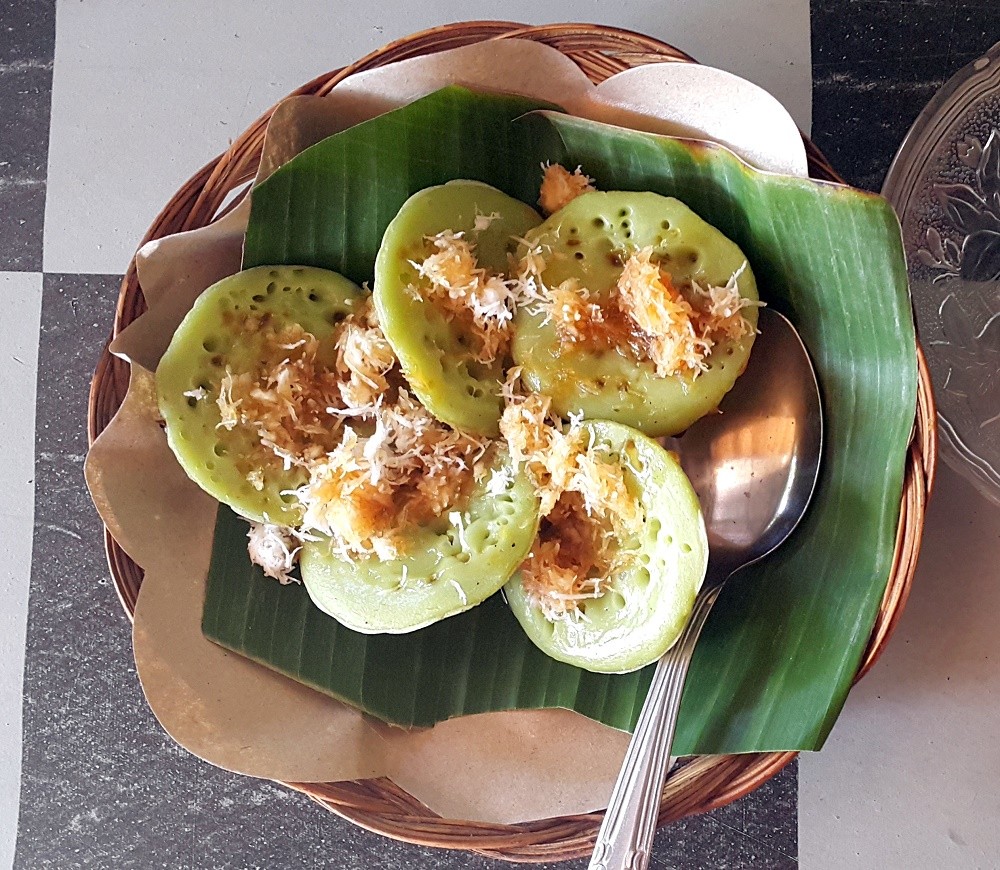 |
| Photo: YoExplore |
Laklak is Balinese traditional little pancake with grated coconut and melted palm sugar. This food is made of rice flour, water, coconut milk, suji leaf extract, baking powder, salt, grated coconut, and brown sugar.
Laklak is a sweet traditional Balinese cake that is made out of rice flour. It usually comes in two colors, white and green. Pandan leaves are used to give it a green color and a light aroma. Laklak is often eaten for breakfast but it is also a great snack that can be eaten any time of the day.
Laklak is hard to find in big cities but it can be found in traditional markets around the island. Don’t forget to try these bite-size cakes that everyone love.
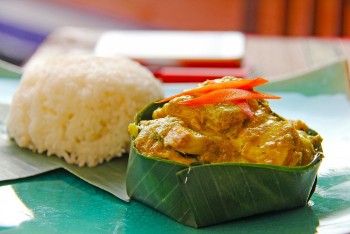 | Cambodian Cuisine: Taste The Most Famous Traditional Food Cambodia is a land of the most exquisite food and dishes that give the most delicious and unique taste ever, from a hot bowl of ... |
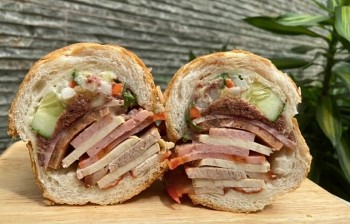 | Vietnam's Most Expensive Banh Mi: What's So Special? These banh mi have impressive fillings |
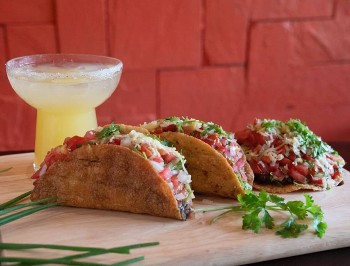 | Have You Tried This UNESCO-Recognized Food? Let’s start a culinary trip to find out why these food are “cultural heritage” that you must try at least once. |
Recommended
 World
World
Pakistan NCRC report explores emerging child rights issues
 World
World
"India has right to defend herself against terror," says German Foreign Minister, endorses Op Sindoor
 World
World
‘We stand with India’: Japan, UAE back New Delhi over its global outreach against terror
 World
World
'Action Was Entirely Justifiable': Former US NSA John Bolton Backs India's Right After Pahalgam Attack
 World
World
US, China Conclude Trade Talks with Positive Outcome
 World
World
Nifty, Sensex jumped more than 2% in opening as India-Pakistan tensions ease
 World
World
Easing of US-China Tariffs: Markets React Positively, Experts Remain Cautious
 World
World


